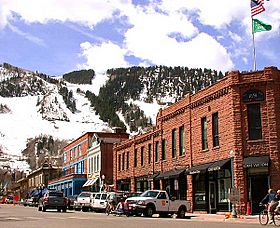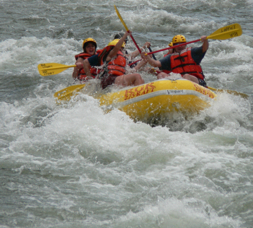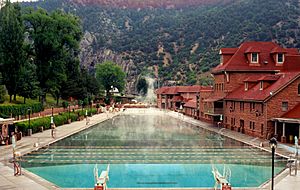Roaring Fork Valley facts for kids
Quick facts for kids
Roaring Fork Valley
|
|
|---|---|

Aspen
|
|

Carbondale
|
|

Glenwood Springs
|
|
| Country | |
| State | |
| Major cities | Glenwood Springs - Aspen - Carbondale - Basalt |
| Population
(2010 est.)
|
|
| • | 32,179 |
| Time zone | UTC−7 (Mountain Standard Time/MST) |
| • Summer (DST) | UTC−6 (MDT) |
The Roaring Fork Valley is a beautiful area in western Colorado, United States. It's known for being a wealthy region with many people and important businesses. The valley gets its name from the Roaring Fork River and its smaller rivers, like the Crystal and Fryingpan River.
The valley includes several towns such as Aspen, Snowmass Village, Basalt, Carbondale, and Glenwood Springs. Mount Sopris and the Roaring Fork River are important symbols of this region.
Valley History
Before settlers from the U.S. arrived in 1879, the Ute lived in the valley. The first U.S. settlers came over Independence Pass. They were looking for silver during the Colorado Silver Boom, similar to what was happening in nearby Leadville.
The town of Aspen grew quickly as a mining community in the late 1880s and early 1890s. However, the silver market crashed in 1893, which greatly affected the town. Later, coal mining became important in the Crystal River valley. Most of this mining has stopped now, though some coal is still mined south of McClure Pass.
Valley Geography
The Roaring Fork Valley is part of a larger area called the Roaring Fork Watershed. This watershed also includes the Fryingpan and Crystal River valleys. The valley stretches for about 50 miles (80 km) from Aspen in the southeast to Glenwood Springs in the northwest. It is between 1 and 5 miles (1.6 and 8.0 km) wide.
High mountains surround the valley, especially the Elk Mountains to the southwest. These mountains are home to the Aspen/Snowmass ski resorts. The upper part of the valley, near Aspen, is sometimes called the Aspen Valley. Locals often call it "up-valley" (Aspen) and "down-valley" (Glenwood Springs). Mount Sopris stands tall at the lower end of the valley and is a well-known symbol of the area. Many people also see the Roaring Fork River as a symbol of the region.
Valley Economy
The main reason the valley's economy is strong is the Aspen/Snowmass ski area. Skiing brings in tourists, which helps many other businesses. These include hotels, shops, construction, real estate, and property services.
Even though skiing is key, other activities also attract visitors all year. People enjoy fly fishing on the Fryingpan River and whitewater rafting on the Roaring Fork River. Hiking near the Maroon Bells in the Maroon Bells–Snowmass Wilderness is also popular. In Glenwood Springs, visitors can enjoy the caverns and hot springs. Events like the Aspen Institute conferences and the Aspen Music Festival also draw crowds.
Most of the land around the valley is part of the White River National Forest. This forest offers many chances for outdoor fun and tourism. Agriculture, mainly raising animals, is a small and shrinking part of the valley's economy. However, the ranches still make the lower valley beautiful and help with tourism. Growing potatoes used to be important in the lower valley, but it's not common anymore.
Valley Population
The Roaring Fork Valley has been growing very quickly in recent years. This growth is not just around Aspen but also in the lower valley, especially below Basalt. Towns like Basalt and Carbondale have become places where people who work in Aspen live. This is because housing in Aspen is very expensive. It's hard for workers with lower or middle incomes to afford to live there. The wealth from the upper valley is slowly spreading to other parts of the valley. Many workers in Glenwood Springs also live further down the Colorado River because of the lack of affordable homes.
State Highway 82 is the main road through the valley. It has features like a freeway. What used to be quiet, rural areas now have almost continuous buildings connecting the four main towns. Even though some parts of the valley are still rural, there is a public transportation system. It's called the Roaring Fork Transportation Authority, and it provides bus service between Aspen and Glenwood Springs.
Valley Communities
- Aspen
- Basalt
- Carbondale
- El Jebel
- Glenwood Springs
- Snowmass Village
- Snowmass (sometimes called "Old Snowmass")
- Woody Creek
- Marble (Crystal Valley)
- Meredith (Fryingpan Valley)
- Redstone (Crystal Valley)
- Cattle Creek



